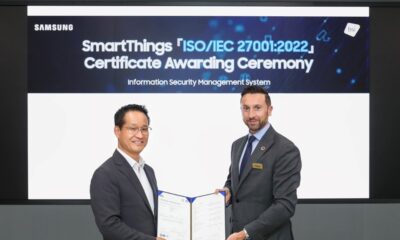
Breaking 5G speed records, Samsung gains 5.23Gbps by combining 4G LTE and 5GmmWave
On March 3, 2021, Samsung announced that it gained a breakthrough in 5G data speeds using E-UTRAN New Radio Dual Connectivity (EN-DC) technology. The EN-DC technology enables mobile operators to boost 5G speeds and coverage by leveraging a 4G network.
In contrast, the company successfully combined 40MHz of 4G frequency and 800MHz of 5G frequency of mmWave, in a demonstration carried out in Samsung’s lab in Korea and achieved 5.23Gbps in data speeds to a single device. The successful demonstration presents a blueprint for bringing a rapid, stable, and effective path to the 5G service.
In the demonstration, Samsung used its commercial end-to-end solutions, including equipment and network products. These include Samsung Galaxy S20+ smartphones, 4G radio, 5G radio (compact macro), and 4G/5G universal core.

The EN-DC technology allows operators to combine 4G and 5G to maximize the benefits of both networks to deliver enhanced coverage, speeds, and reliability. Besides, it leveraged carrier aggregation which combines multiple channels of the spectrum to gain greater efficiencies and boost data speeds over a wireless network.
“This reinforces our commitment to delivering the best possible 5G solutions to our customers and our ongoing support to help mobile operators accelerate the benefits of 5G services to their users,” said Ji-Yun Seol, Vice President, and Head of Air Technology Group, Networks Business at Samsung.
Join us on Telegram
This achievement is based on Samsung’s years of research on 5G and the company’s firm commitment to enhancing the network experience of each user. Beginning in 2018, Samsung has begun to demonstrate the capabilities of 5G, which is the first gigabit 5G New Radio (NR) data connection (link) with a speed exceeding 1.7Gbps.
In 2019, Samsung broke its record, reaching a data speed of 2.65Gbps, and subsequently reached a speed of 4.3Gbps in a demonstration in 2020. Today, Samsung has reached a data speed of 5.23Gbps, using a flexible new method in EN-DC technology to overcome another obstacle.
Tip Corner (Have any suggestion? send us on contacts below)
- [email protected]
- Message us on Twitter
- Follow SammyFans.com on Facebook
Ed Gubbins, Principal Analyst at GlobalData said – “Mobile operators need to make the most of their finite spectrum assets in order to ensure user experiences that deliver the full value of 5G. “This achievement showcases Samsung’s distinguishing ability to leverage an end-to-end portfolio and broad expertise that spans core, RAN and devices to help operators maximize the return on their 5G investments.”
News
Here’s why Google Messages replaced Samsung Messages on Galaxy devices

Samsung’s latest foldable phones come with Google Messages by default. The company has now revealed the reason behind this move on Galaxy devices. Samsung says Google Messages replaced Messages to foster RCS adoption.
According to AndroidAuthority, a source explained Samsung’s decision to switch to Google Messages as the default messaging app. The recently released Galaxy Z Flip 6 and Z Fold 6 come with Google Messages with RCS enabled by default.
Looks like promoting Google Messages on Galaxy devices will boost RCS adoption. Samsung Messages isn’t already installed on newer phones. However, one’s stopping you from getting it on your Galaxy from the Galaxy Store.
While many apps support the RCS feature, Google Messages offer the best user experience. Making it a default messaging app is an effort to boost the adoption of RCS tech. Apple is also preparing to bring RCS chat functionality to iMessage for iPhones.
What Samsung source said:
- Even if messaging apps follow the RCS standard, the availability may be limited depending on which app the other party uses. That’s why we decided to make Google Messages the common messaging platform, allowing Galaxy users to communicate more freely. This also enables a messaging app to respond to changes of the RCS standard more quickly and efficiently.
Previously, Samsung devices launched in the US came with two messaging apps. This time, the company has removed the Samsung Messages. During the first setup, users are notified that Google Messages is the default messaging application.
News
Samsung SmartThings gets ISO 27001 certified

Samsung SmartThings gained the international standard ISO/IEC 27001:2022 certification. The company has officially announced this major development in its global connected living platform.
SmartThings received ISO/IEC 27001:2022 certification for information security management systems. Certification reiterates that the SmartThings Cloud operates per international standards.
To be certified, a company has to meet the standard across a total of 123 detailed items, including policies for information security, access control for information assets, and incident response.
SmartThings receiving the ISO 27001 certification is the result of our sustained focus on the protection of information in a hyper-connected world with exponentially increasing intelligence.
Seungbum Choi, Executive Vice President and Head of Device Platform Center at Samsung Electronics said “this is just another step in our drive to fortify the platform’s security. We will continue to find new ways to ensure that SmartThings’ personalized services are provided even more safely.”

BSI Prez says that they have recognized that the operation capability and security level of Samsung SmartThings is excellent. It will further boost trust in the SmartThings platform and strengthen business competitiveness.
ISO 27001 is the leading global standard for ISMSs and was established by the International Organization for Standardization. It provides companies with guidance to manage the risks to information assets systematically and achieve information protection goals.
News
Dr.diary fuels Samsung Health with glycated hemoglobin algorithm
Samsung Health app integrated the Dr.diary (Doctor Diary) glycated hemoglobin feature. The blood sugar management platform announced the launch of its glycated hemoglobin estimation functionality on Samsung’s Health application.
According to ETNews, Dr.diary announced the integration of a glycated hemoglobin level feature in Samsung Health. Galaxy users will now be able to check the estimated glycated hemoglobin level provided by Doctor Diary.
To activate the feature, Health app users will have to permit certain conditions of data in the Blood Sugar service. It is worth noting that glycated hemoglobin is a key figure for diabetes diagnosis, which users will find worth using in the Health app.
Established in 2017, Dr.diary is a blood sugar management platform. It analyzes and predicts the changes in glycated hemoglobin using its own algorithm. Earlier this year, the firm secured a patent for “glycated hemoglobin estimation based on blood sugar data table.”
Song Je-yoon, CEO of Doctor Diary, said, “With our predicted glycated hemoglobin level prediction algorithm being installed in Samsung Health, more people will be able to recognize their glycated hemoglobin level and manage their health more efficiently.”

Glycated hemoglobin (HbA1c) is a standardized numerical value of the percentage of hemoglobin, such as hemoglobin, which has been glycated by glucose. Glycated hemoglobin reflects the average blood sugar level over the past 2-3 months.
Samsung Health (with Wear OS Galaxy Watch) users can conveniently check their estimated glycated hemoglobin level within the app and use this information to manage their blood sugar levels through diet and exercise.












